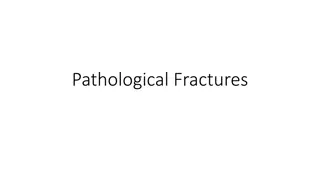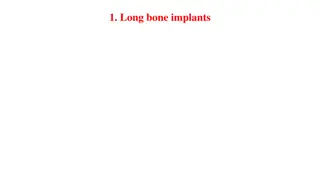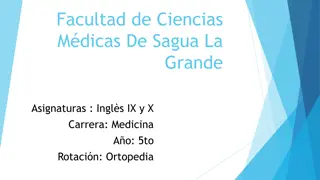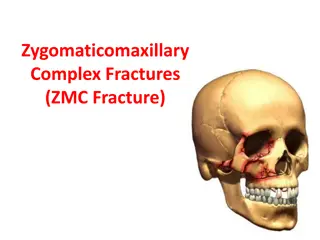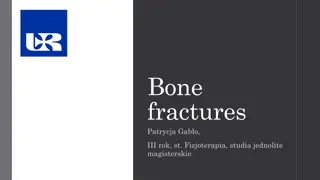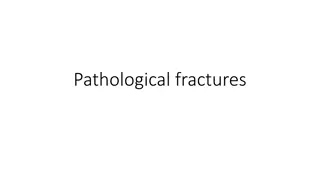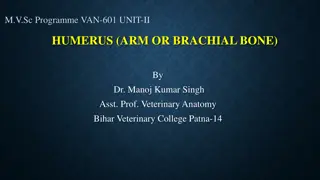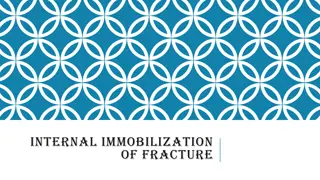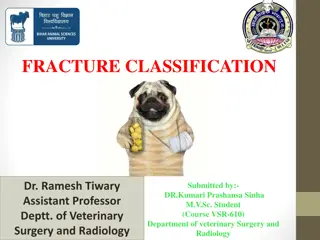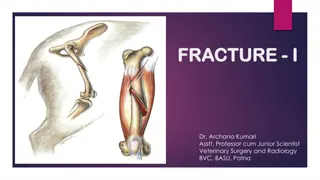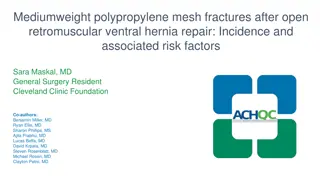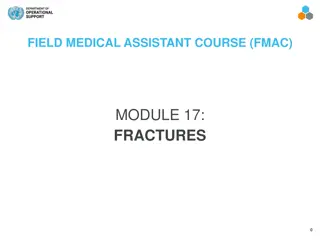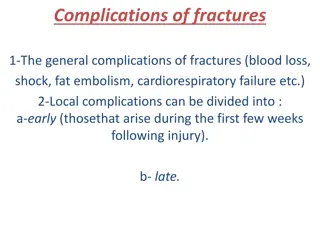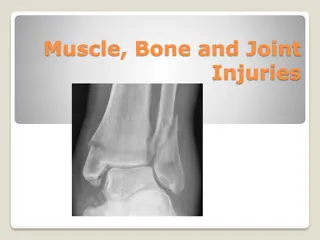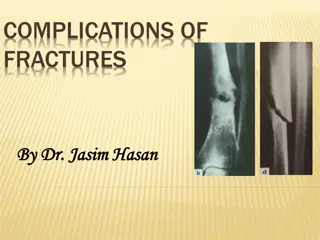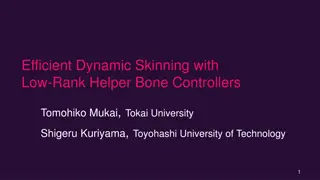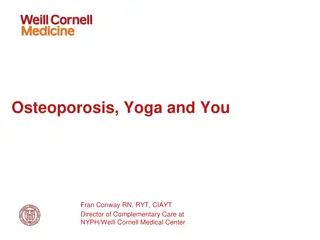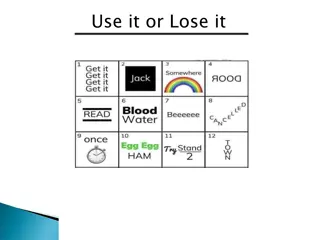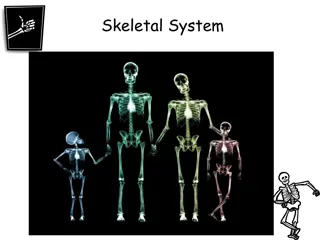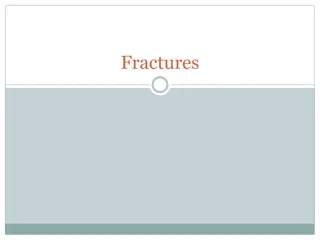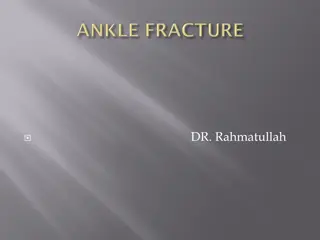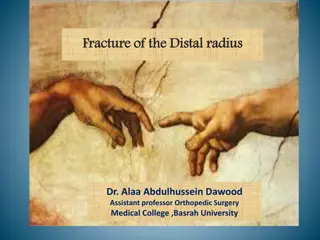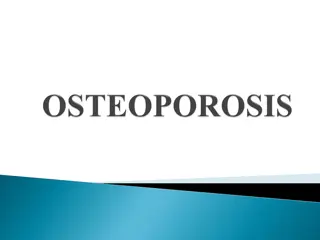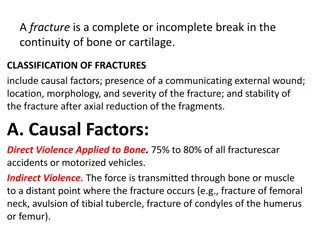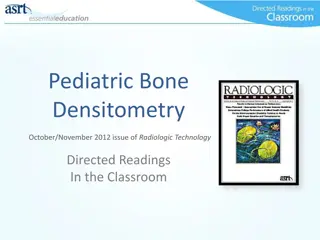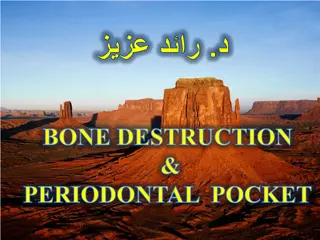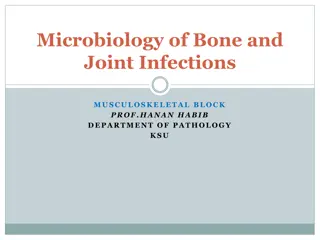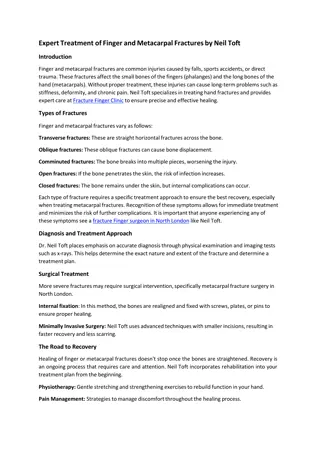Spinal injuries
An overview of spinal injuries, including anatomy revision, types of spinal fractures, assessment, management, and common patterns of injuries. It also covers back pain presentation, red flags, differentials, and the structure of vertebrae. The Denis classification of spinal fractures and the most c
3 views • 40 slides
Pathological Fractures
Pathological fractures occur in weakened bones due to underlying diseases or conditions, often manifesting with minimal trauma. Common causes include neoplastic lesions, infections, metabolic imbalances, and developmental disorders. Recognizing these fractures is crucial for timely intervention and
1 views • 20 slides
Understanding Long Bone Implants and Osteosynthesis Techniques
Fractures in long bones can be categorized based on their form, aiding in prognosis and management. Different types of fractures include comminuted, transverse, oblique, crushing, intra-articular, detachment, and selected fractures. Long bone implants play a crucial role in osteosynthesis, with mate
1 views • 22 slides
Understanding Bone Anatomy and Composition
Explore the intricate details of bone structure and function, from the classification of bones by shape to the constituents of bone tissue. Learn about the essential role bones play in providing structural support, protection, and blood cell production. Delve into the anatomy of long and flat bones,
7 views • 31 slides
Understanding Bone Fractures in Orthopedic Medicine
Explore the features, causes, signs, and classifications of bone fractures in orthopedic medicine, including mechanisms, soft tissue involvement, displacement, and fracture patterns. Learn about the definition and common symptoms associated with bone fractures. Images and descriptions provide insigh
3 views • 25 slides
Understanding Zygomaticomaxillary Complex Fractures
Zygomaticomaxillary complex fractures, commonly referred to as ZMC fractures, are significant facial injuries often caused by trauma. These fractures can involve different parts of the zygoma bone, leading to various classifications based on severity and displacement. Proper diagnosis and appropriat
7 views • 52 slides
Bone Fractures
Bone fractures can occur due to external forces, high-energy trauma, bone fatigue, or underlying skeletal diseases. Symptoms include pain, tenderness, swelling, and difficulty moving. Different types of fractures include nondisplaced, displaced, compound, pathological, longitudinal, and spiral fract
0 views • 15 slides
Bone Marrow Transplant Cost in India
The supple, fatty tissue found inside your bones is called bone marrow. The cells that make blood and platelets are found in bone marrow, which also produces billions of new blood cells daily.\nA bone marrow transplant (BMT) includes using healthy blood-forming stem cells to replace the patients' di
1 views • 2 slides
Abattoir Practices and Bone Products Technology Overview
Bone constitutes a significant portion of the dressed carcass weight, with various types such as fresh green bone and desert bone. Bones are used in various industries for products like glue, gelatine, and fertilizer. Different methods of bone processing are employed to extract valuable components l
0 views • 42 slides
Understanding Peak Bone Mass and Bone Health in Adolescents
Discussing the importance of peak bone mass in adolescents for bone strength and the prevention of osteoporosis. Topics include factors influencing peak bone mass, interventions to optimize bone health, and risks associated with poor nutrition and eating disorders.
1 views • 45 slides
Understanding Fractures: Traumatic vs. Pathological and Modeling Options
Defining the distinction between traumatic and pathological fractures, exploring the relationship between non-traumatic fractures and underlying bone pathologies, and discussing modeling options for classifying fractures. Stress fractures, insufficiency fractures, and the causes of pathological frac
3 views • 8 slides
Anatomy of the Humerus Bone in Veterinary Science
The humerus bone, also known as the arm or brachial bone, plays a crucial role in forming the shoulder and elbow joints. It features a shaft with distinct surfaces and nutrient foramen. The proximal extremity includes a head, neck, tuberosities, and a bicipital groove for various muscle attachments.
0 views • 15 slides
Methods of Internal Immobilization for Fracture Repair
Various methods of internal immobilization for fracture repair in animals include intramedullary pinning and nailing, Rush pins, cross pinning, screws, wires, and plate fixation. These methods provide stability and alignment for bone fractures, with success rates depending on the size and weight of
0 views • 21 slides
Understanding Fracture Classification in Veterinary Medicine
Fractures in veterinary medicine can be classified based on various factors such as communication with the environment, extent of bone damage, and complexity of the injury. This comprehensive guide covers different types of fractures, including simple, compound, complicated, and incomplete fractures
2 views • 16 slides
Innovative Polymer-Metal Bone Substitute for Enhanced Healing
Novel PEKK/tantalum/eADF4(C16) bone substitute developed to address limitations of current bone grafting materials. Combines antibacterial properties with osseointegration capabilities, offering potential for successful bone healing and growth. Research plan involves preparation, testing of properti
0 views • 10 slides
Overview of Inflammatory Diseases of Bone
Inflammatory diseases of bone encompass conditions like osteitis, osteomyelitis, periostitis, and alveolar osteitis (dry socket). Osteitis is localized and may be associated with infected sockets, while osteomyelitis involves the interior of the bone. Alveolar osteitis commonly follows tooth extract
0 views • 20 slides
Understanding Bone Development and Composition in Veterinary Science
Bone development in animals involves the differentiation of mesenchymal cells into various bone components like osteoblasts, osteocytes, and osteoclasts. This process leads to the formation of specialized connective tissue that provides skeletal support, muscle leverage, and protection for vital org
3 views • 15 slides
Sports-related Injuries and Mechanisms
This content discusses various sports-related injuries and their mechanisms, including shin splints, foot fractures, ankle sprains, and Achilles tendonitis. Each injury is described with its signs and symptoms, along with the mechanisms that caused them. The injuries range from stress fractures in t
1 views • 105 slides
Incidence of Mesh Fractures in Open Ventral Hernia Repair with Mediumweight Polypropylene Mesh
This study aims to characterize the occurrence of mesh fractures in open ventral hernia repair using mediumweight polypropylene mesh and identify associated risk factors. The research focuses on patients at Cleveland Clinic from January 2014 to April 2022, emphasizing retromuscular placement and a o
1 views • 19 slides
Tactical Field Medical Assistant Training - Fractures Assessment and Management
Explore the Tactical Field Medical Assistant Course training modules focusing on fractures assessment and management. Learn to identify fracture warning signs, differentiate between closed and open fractures, and demonstrate proper splint application. Gain knowledge on caring for fractures in tactic
1 views • 19 slides
Insights into Vertebral Fractures and Bone Health
Delve into the world of vertebral fractures and bone health with Dr. Frazer Anderson. Explore the impact of fractures, the importance of understanding the spine, and how to treat and prevent fractures effectively. Uncover fascinating bone factoids and learn about bone turnover and the factors that c
0 views • 24 slides
Understanding Complications of Fractures: Early and Local Manifestations
Fractures can lead to a variety of complications, ranging from general issues like blood loss and shock to local problems such as nerve injury and joint stiffness. Early complications may include visceral or vascular injuries, requiring prompt medical attention. Proper diagnosis and treatment are cr
0 views • 26 slides
Understanding Muscle, Bone, and Joint Injuries: Care and Treatment
Explore musculoskeletal injuries, head and back injury signals, and proper care techniques. Learn about ligaments, sprains, strains, fractures, dislocations, and RICE treatment for strains and sprains. Discover why RICE method is beneficial and methods for splinting fractures and dislocations.
0 views • 27 slides
Complications of Fractures: Types and Risks
Complications of fractures can be classified as general, local early, and late complications. General complications include shock, embolisms, and fever while local complications involve injuries to nearby tissues and infections. Early local complications can lead to visceral, vascular, nerve injurie
0 views • 29 slides
Complications of Fractures and Their Management by Dr. Jasim Hasan
This detailed presentation by Dr. Jasim Hasan covers the complications of fractures, including general and local complications, early and late complications, and specific issues such as shock, vascular injuries, nerve damage, and more. The information highlights the importance of recognizing and add
0 views • 29 slides
Efficient Dynamic Skinning with Low-Rank Helper Bone Controllers
This research explores efficient dynamic skinning methods using low-rank helper bone controllers to achieve robust, simple, and high-performance skin deformation in computer graphics. By investigating linear blend skinning techniques and helper bone rigs, the study aims to address the wishlist of ga
0 views • 29 slides
Understanding Osteoporosis and the Role of Yoga in Bone Health
Osteoporosis is a condition characterized by low bone mass, leading to increased fracture risk. This presentation delves into the definitions of osteoporosis and osteopenia, outlines key statistics on bone health in the U.S., discusses risk factors such as age, genetics, and lifestyle habits, and ex
0 views • 24 slides
Understanding the Importance of Calcium for Bone Health
Adequate calcium consumption is crucial for maintaining healthy bones, teeth, and overall body function. Failure to achieve peak bone mass in adulthood could lead to conditions like osteoporosis. Calcium-rich foods like dairy products, dark green leafy vegetables, and fortified foods play a vital ro
0 views • 18 slides
Exploring the Human Skeletal System
The skeletal system plays crucial roles in supporting the body, protecting internal organs, facilitating movement with muscles, and producing blood cells. It consists of various bone structures like periosteum, compact bone, spongy bone, and bone marrow. The cranium houses important bones such as th
0 views • 53 slides
Understanding Different Types of Fractures and Their Characteristics
Explore various types of fractures such as traumatic, pathologic, compressive, and more through detailed medical images and authentic reports. Learn about the severity of soft tissue damage, classifications by renowned professionals, and the significance of assessing soft tissue injuries. Delve deep
0 views • 28 slides
Comprehensive Overview of Ankle Fractures and Ligamentous Anatomy
Ankle fractures are more prevalent in elderly women, with isolated malleolar fractures being the most common type. Understanding the complex hinge joint and ligamentous structures of the ankle is essential for diagnosis and treatment. The syndesmotic ligament complex plays a crucial role in stabiliz
0 views • 44 slides
Distal Radius Fracture: Diagnosis, Management, and Complications
Distal radius fractures, particularly Colles fractures, are common injuries, often affecting elderly women due to osteoporosis. These fractures typically result from a fall onto an outstretched hand, causing dorsal and sometimes radial displacement of the distal radius fragment. Clinical features in
0 views • 32 slides
Understanding Osteoporosis and Its Classification
Osteoporosis is a skeletal disease resulting in low bone mass and increased fragility. It occurs due to an imbalance in bone formation and resorption, leading to weakened bones and higher fracture risk. The disease is classified into primary and secondary types, with various subcategories based on a
0 views • 19 slides
Understanding Fractures: Classification and Factors
A fracture is a break in bone continuity, classified by causal factors, presence of external wounds, location, morphology, severity, and stability post-reduction. Fracture causes include direct violence, indirect violence, bone diseases, and repeated stress. Fractures can be closed or open, with sev
0 views • 17 slides
Comprehensive Guide to Management of Fractures in Animals
This detailed guide covers the diagnosis and surgical treatment of humeral diaphyseal fractures, supracodylar fractures, and radial and ulnar fractures in animals. It includes information on immobilization techniques, diagnostic imaging, and surgical options for optimal management of bone injuries i
1 views • 21 slides
Pediatric Bone Health: Imaging and Assessment in Children
Discussions on the importance of assessing bone density in pediatric patients, focusing on skeletal development, anatomy, and types of bone tissue. Exploring how bone densitometry can help identify diseases affecting bone growth in children and adolescents to prevent future complications like osteop
0 views • 64 slides
Understanding Bone Destruction in Periodontal Disease
The progression of periodontal disease can lead to bone destruction in the alveolar bone, which is crucial in supporting teeth. The inflammatory process causes permanent damage to the periodontium tissues, resulting in connective tissue loss and bone resorption. Different patterns of bone loss, such
0 views • 14 slides
Understanding Biological Changes with Light or Heavy Forces Application
Tooth movement can be categorized as physiologic, pathologic, or orthodontic, with forces transmitted through the tooth to the periodontal ligament and alveolar bone. Changes occurring due to light and heavy forces result in bone resorption and deposition, impacting the supporting structures. Histol
0 views • 25 slides
Overview of Microbiology in Bone and Joint Infections
Bone and joint infections can have devastating effects if not treated promptly. They can be caused by blood-borne spread or local trauma and are more common in infants and children. Acute osteomyelitis, a common type of bone infection, can last from a few days to several weeks or months. Understandi
0 views • 35 slides
Best Fracture Finger & Metacarpal Fractures Treatment Clinic in North London
NeilToft is a Consultant Surgeon for Fracture Finger & Metacarpal Fractures Surgery in North London, Stanmore, Pinner, Rickmansworth, Watford, etc. Book an Appointment for Fracture Finger & Metacarpal Fractures Treatment.\n
1 views • 2 slides

